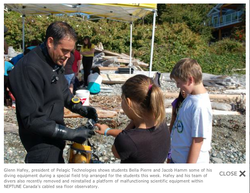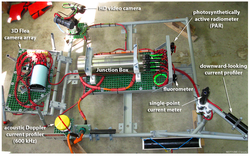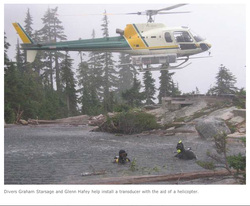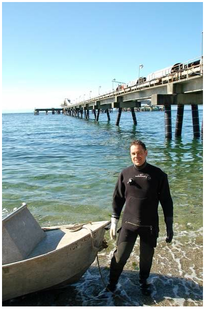Coast Reporter September 21, 2012 (CHRISTINE WOOD)

Divers from Pelagic Technologies recently revisited the platform they installed as part of NEPTUNE Canada’s cabled sea floor observatory, to fix some problems and add new cameras.
The local diving company was contracted by NEPTUNE Canada to install and care for the platform, which holds a multitude of cameras and sensors constantly streaming information about the underwater area to the web. There researchers and lay people alike can access it.
The platform sits about 23 metres underwater in Folger Passage, just off the coast of Vancouver Island near Bamfield. It is one of six such platforms connected by cables that stretch out across the Juan De Fuca plate and back to a shore station in Port Alberni.
Pelagic installed their platform by first bolting a frame to a sheer underwater rock face in August of 2010. The company then attached the platform to it, which held about a half million dollars worth of scientific instruments.
The underwater science observatory was powered up and connected to the NEPTUNE Canada network in early 2011.
“The NEPTUNE Canada project is one of a kind. There are other countries I believe that have tried to do it and have failed, so it’s the first successful underwater cable observatory,” said Pelagic president Glenn Hafey.
The project allows researchers a fish-eye view of the underwater world at depths up to 2,660 metres below the surface.
“The biggest thing about this whole idea is the fact that researchers have a very hard time coming up with the budget and booking time to get on research ships so now what they can do is they can tap into these instruments on-line,” Hafey said.
The instruments range from three-dimensional cameras to sensors that measure things like temperature, plankton, microbes and even seismic activity.
Some of the cameras on the platform Pelagic installed malfunctioned, however.
“There was an Internet controlled camera that was a pan-and-tilt camera, so it was designed to be able to look around in all conditions, rough and calm conditions, and there was a deep camera of the same make and they both failed,” Hafey said. “I don’t know the details on why it failed, but it didn’t work right from the beginning, but the 3-D camera was getting good images and then it failed as well.”
The instruments couldn’t be fixed underwater, he said.
“Originally it was made to not have an underwater disconnection, it was all hard wired in, so we as divers couldn’t get into the guts of the power source so it had to be pulled up,” Hafey said.
The platform was pulled from the water this summer, fixed and lowered back into place last month by the team at Pelagic.
“The instrument technicians have made what they call wet connections in case we have to do anything in the future,” Hafey said.
His team is proud to be a part of the NEPTUNE Canada project, which is massive in scale but limited in publicity.
“Interestingly for such a big and successful science project not many people know about it. I think CBC ranked it four out of the top ten and Popular Mechanics ranked it eight out of ten internationally. I think it even beat the Mars program on the CBC rating,” Hafey said.
To find out more about the project go to www.neptunecanada.com.
The local diving company was contracted by NEPTUNE Canada to install and care for the platform, which holds a multitude of cameras and sensors constantly streaming information about the underwater area to the web. There researchers and lay people alike can access it.
The platform sits about 23 metres underwater in Folger Passage, just off the coast of Vancouver Island near Bamfield. It is one of six such platforms connected by cables that stretch out across the Juan De Fuca plate and back to a shore station in Port Alberni.
Pelagic installed their platform by first bolting a frame to a sheer underwater rock face in August of 2010. The company then attached the platform to it, which held about a half million dollars worth of scientific instruments.
The underwater science observatory was powered up and connected to the NEPTUNE Canada network in early 2011.
“The NEPTUNE Canada project is one of a kind. There are other countries I believe that have tried to do it and have failed, so it’s the first successful underwater cable observatory,” said Pelagic president Glenn Hafey.
The project allows researchers a fish-eye view of the underwater world at depths up to 2,660 metres below the surface.
“The biggest thing about this whole idea is the fact that researchers have a very hard time coming up with the budget and booking time to get on research ships so now what they can do is they can tap into these instruments on-line,” Hafey said.
The instruments range from three-dimensional cameras to sensors that measure things like temperature, plankton, microbes and even seismic activity.
Some of the cameras on the platform Pelagic installed malfunctioned, however.
“There was an Internet controlled camera that was a pan-and-tilt camera, so it was designed to be able to look around in all conditions, rough and calm conditions, and there was a deep camera of the same make and they both failed,” Hafey said. “I don’t know the details on why it failed, but it didn’t work right from the beginning, but the 3-D camera was getting good images and then it failed as well.”
The instruments couldn’t be fixed underwater, he said.
“Originally it was made to not have an underwater disconnection, it was all hard wired in, so we as divers couldn’t get into the guts of the power source so it had to be pulled up,” Hafey said.
The platform was pulled from the water this summer, fixed and lowered back into place last month by the team at Pelagic.
“The instrument technicians have made what they call wet connections in case we have to do anything in the future,” Hafey said.
His team is proud to be a part of the NEPTUNE Canada project, which is massive in scale but limited in publicity.
“Interestingly for such a big and successful science project not many people know about it. I think CBC ranked it four out of the top ten and Popular Mechanics ranked it eight out of ten internationally. I think it even beat the Mars program on the CBC rating,” Hafey said.
To find out more about the project go to www.neptunecanada.com.
Neptune Canada February 7, 2011 (Dwight Owens)
Folger's Pinnacle Connected

Our Folger Pinnacle instrument platform is now up and running after a team of divers plugged in the extension cable connecting it to Folger Passage Node and the rest of the NEPTUNE Canada network last week. Glenn Hafey of Pelagic Technologies made the actual connection after he and his 4-man team dove 23m to the platform from the Bamfield Marine Science Centre’s 9.8m aluminum dive support boat, the Barkley Star.
After the dive team was safely out of the water, we held our collective breath as our systems team powered up the platform and sent the first ping. Happily, the platform’s junction box responded! One by one, we then sparked up all 7 platform instruments.
For the full story check NEPTUNE CANADA'S site
After the dive team was safely out of the water, we held our collective breath as our systems team powered up the platform and sent the first ping. Happily, the platform’s junction box responded! One by one, we then sparked up all 7 platform instruments.
For the full story check NEPTUNE CANADA'S site
A global science project in Sechelt
PELAGIC TECHNOLOGIES

APRIL 1, 2011
ALLIE NICHOL/STAFF WRITER
Working on one of the most important ongoing global science projects is a big title to lay claim to, but Sechelt-based engineering and environmental consulting firm Pelagic Technologies has been able to do just that.
Recently, Pelagic president Glenn Hafey and his team of science divers completed the second phase of work on the NEPTUNE Canada cabled sea floor observatory, an 800 km length of cable linked to various nodes that gather information. Everything from 3D cameras to capture images of ocean life to sensors that measure temperature, plankton, microbes, chemicals and seismic activity make up the project and its ability to stream on-line.
The first phase, initialized in August 2010, consisted of a highly delicate data-collecting instrument frame being laid on the sea bottom, which proved to be challenging.
The second phase of powering up the node proved to be even more difficult. Hafey and his team dove 23 metres to plug in the extension cord connecting the node to NEPTUNE Canada’s network platform, located in Bamfield.
“This has been the hardest one for NEPTUNE to be able to [install]. The rest of them had been laid on the sea bottom. This one had to be bolted to the reef itself. First finding an appropriate site, which took two different trips, for a structural thing to be attached to the reef, and then combine that with the science that’s necessary and the organisms they were targeting. Combine those three events with that surge and how powerful the water is out there. It was terribly difficult,” Hafey explained.
After the team was safely out of the water, they held their collective breath as they powered up the platform.
“No one knew, even after all this effort, if it was actually going to start streaming data,” said Hafey.
The lights came on, one by one. The project was a success, and Hafey said the team was ecstatic.
As for future plans, Pelagic Technologies has several projects on the go, including further work with NEPTUNE Canada that will see Hafey and his team dive back down to adjust the underwater cameras to record specific sea life and perform simple maintenance.
Hafey also explained the company is looking at creating a local community event this summer that will involve a demonstration dive. The team will collect various forms of sea and marine life and bring them to the surface for a community “show and tell” in hopes of encouraging kids of all ages to gain an interest in marine studies.
Event details will be released once a date is set.
To view the underwater camera footage, visit NEPTUNE Canada’s website at www.neptunecanada.com.
ALLIE NICHOL/STAFF WRITER
Working on one of the most important ongoing global science projects is a big title to lay claim to, but Sechelt-based engineering and environmental consulting firm Pelagic Technologies has been able to do just that.
Recently, Pelagic president Glenn Hafey and his team of science divers completed the second phase of work on the NEPTUNE Canada cabled sea floor observatory, an 800 km length of cable linked to various nodes that gather information. Everything from 3D cameras to capture images of ocean life to sensors that measure temperature, plankton, microbes, chemicals and seismic activity make up the project and its ability to stream on-line.
The first phase, initialized in August 2010, consisted of a highly delicate data-collecting instrument frame being laid on the sea bottom, which proved to be challenging.
The second phase of powering up the node proved to be even more difficult. Hafey and his team dove 23 metres to plug in the extension cord connecting the node to NEPTUNE Canada’s network platform, located in Bamfield.
“This has been the hardest one for NEPTUNE to be able to [install]. The rest of them had been laid on the sea bottom. This one had to be bolted to the reef itself. First finding an appropriate site, which took two different trips, for a structural thing to be attached to the reef, and then combine that with the science that’s necessary and the organisms they were targeting. Combine those three events with that surge and how powerful the water is out there. It was terribly difficult,” Hafey explained.
After the team was safely out of the water, they held their collective breath as they powered up the platform.
“No one knew, even after all this effort, if it was actually going to start streaming data,” said Hafey.
The lights came on, one by one. The project was a success, and Hafey said the team was ecstatic.
As for future plans, Pelagic Technologies has several projects on the go, including further work with NEPTUNE Canada that will see Hafey and his team dive back down to adjust the underwater cameras to record specific sea life and perform simple maintenance.
Hafey also explained the company is looking at creating a local community event this summer that will involve a demonstration dive. The team will collect various forms of sea and marine life and bring them to the surface for a community “show and tell” in hopes of encouraging kids of all ages to gain an interest in marine studies.
Event details will be released once a date is set.
To view the underwater camera footage, visit NEPTUNE Canada’s website at www.neptunecanada.com.
Coast Reporter September 10, 2010 (BRENT RICHTER)
Sechelt’s Pelagic assists in undersea project

Twenty-five metres (80 feet) below the ocean surface, just off the Port Alberni Inlet, Sechelt-based engineering and environmental consulting firm Pelagic Technologies has been hard at work on a project that could revolutionize the way ocean research is done.
Glenn Hafey, president of Pelagic, and his team have completed the first phase of work on the NEPTUNE Canada cabled sea floor observatory, an 800 km length of cable linked to various “nodes” that gather a plethora of information for scientists and lay people alike.
Hafey and his team were awarded the contract to submerge a 1.2-metre square sub-frame to the ocean floor, bolt it into the bedrock then install a 635-kilogram and highly delicate instrument frame worth about $500,000 on top, all while battling heavy undersea surges.
“It was a big challenge. Depth is one thing, but the first time we were out there was March and the surge was so bad that one diver had to hold the other diver in place while they were drilling and we barely got one mooring pin installed in the rock before we got swept out of there,” Hafey said. “At 80 feet, the surge is tremendous.”
But the highly difficult work has its reward, Hafey said. The instrument frames contain everything from 3D cameras and microphones for watching and listening to ocean life to sensors that measure temperature, currents, pressure, seismic activity, chemicals, plankton, microbes and sediment in the water — a virtual underwater laboratory.
“A big challenge for all the people who study everything that has to do with the subsurface of the ocean is that they usually have to go out on a research ship, spend a lot of money, and they’re always limited on time because most of the science groups don’t have the budget to go out endlessly and do research,” he said. “Scientists can tap into all the different independent instruments that are running on these nodes and then download the data to their computers. Someone in Japan could do a study of encrusting colonizations or whales or mammals and not ever have to leave their office. So it’s huge and it’s the first one that’s actually up and running in the world.”
Hafey said while NEPTUNE could benefit ocean science, the various partners that have worked together on it have a much larger audience in mind. Once it is fully up and running, anyone with an internet connection will be able to log in and peer through the high resolution cameras and look at the collected data.
Hafey and his team are expected to complete phase two, powering up the node they installed, in October. To view footage already gathered by NEPTUNE Canada, visit the website at www.neptunecanada.com.
Glenn Hafey, president of Pelagic, and his team have completed the first phase of work on the NEPTUNE Canada cabled sea floor observatory, an 800 km length of cable linked to various “nodes” that gather a plethora of information for scientists and lay people alike.
Hafey and his team were awarded the contract to submerge a 1.2-metre square sub-frame to the ocean floor, bolt it into the bedrock then install a 635-kilogram and highly delicate instrument frame worth about $500,000 on top, all while battling heavy undersea surges.
“It was a big challenge. Depth is one thing, but the first time we were out there was March and the surge was so bad that one diver had to hold the other diver in place while they were drilling and we barely got one mooring pin installed in the rock before we got swept out of there,” Hafey said. “At 80 feet, the surge is tremendous.”
But the highly difficult work has its reward, Hafey said. The instrument frames contain everything from 3D cameras and microphones for watching and listening to ocean life to sensors that measure temperature, currents, pressure, seismic activity, chemicals, plankton, microbes and sediment in the water — a virtual underwater laboratory.
“A big challenge for all the people who study everything that has to do with the subsurface of the ocean is that they usually have to go out on a research ship, spend a lot of money, and they’re always limited on time because most of the science groups don’t have the budget to go out endlessly and do research,” he said. “Scientists can tap into all the different independent instruments that are running on these nodes and then download the data to their computers. Someone in Japan could do a study of encrusting colonizations or whales or mammals and not ever have to leave their office. So it’s huge and it’s the first one that’s actually up and running in the world.”
Hafey said while NEPTUNE could benefit ocean science, the various partners that have worked together on it have a much larger audience in mind. Once it is fully up and running, anyone with an internet connection will be able to log in and peer through the high resolution cameras and look at the collected data.
Hafey and his team are expected to complete phase two, powering up the node they installed, in October. To view footage already gathered by NEPTUNE Canada, visit the website at www.neptunecanada.com.